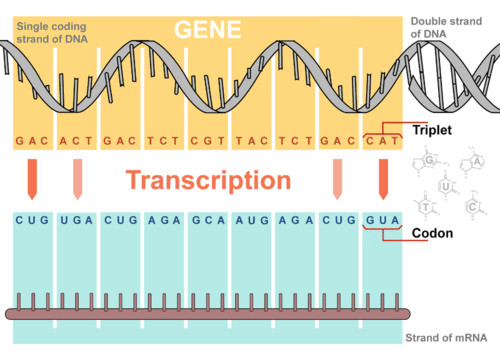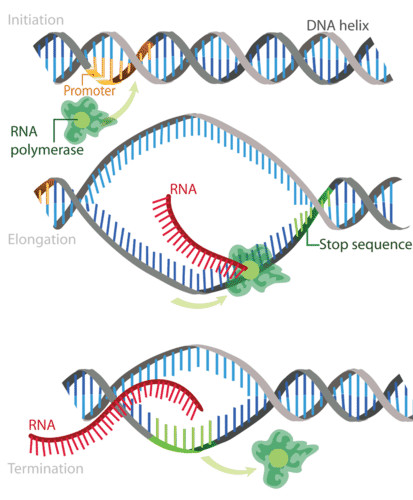Transcription, the fundamental process in gene expression, is the creation of ribonucleic acid (RNA) from a deoxyribonucleic acid (DNA) template. But Where Does Transcription Take Place within the cell? The answer lies in the cell’s control center: the nucleus. In eukaryotic cells, the nucleus serves as the dedicated site for DNA storage and, consequently, for transcription.
Think of the nucleus as the command center of the cell. It houses the cell’s genetic blueprint, DNA, which contains all the instructions necessary for life. Transcription is the first crucial step in accessing and utilizing these instructions. This process must occur in close proximity to the DNA to ensure efficiency and accuracy. Therefore, the nucleus provides the ideal environment for transcription to unfold.
Let’s delve deeper into the process of transcription and understand why the nucleus is the perfect location for it. Transcription can be broken down into three key stages: initiation, elongation, and termination, all of which occur within the nucleus.
 Overview of transcription of DNA to mRNAFigure 1. Transcription Location: An Overview of DNA to mRNA Synthesis. This illustration shows how the DNA template within the nucleus is used to create a complementary mRNA strand during transcription. Notice the distinct molecules involved and the resulting mRNA ready for the next step in gene expression.
Overview of transcription of DNA to mRNAFigure 1. Transcription Location: An Overview of DNA to mRNA Synthesis. This illustration shows how the DNA template within the nucleus is used to create a complementary mRNA strand during transcription. Notice the distinct molecules involved and the resulting mRNA ready for the next step in gene expression.
The Stages of Transcription in the Nucleus
Transcription is a tightly regulated process, ensuring that the correct genes are transcribed at the right time. Each stage plays a vital role in the accurate synthesis of RNA.
Initiation: Starting the RNA Synthesis
Initiation marks the beginning of transcription. This crucial step starts when an enzyme called RNA polymerase binds to a specific region of a gene known as the promoter. The promoter region acts as a signal on the DNA, indicating to RNA polymerase where to begin transcription. This binding signals the DNA double helix to unwind at the specific gene location, creating a template for RNA synthesis. Essentially, initiation sets the stage for RNA polymerase to access the DNA sequence and begin “reading” the genetic code.
Elongation: Building the mRNA Molecule
Elongation is the stage where the RNA molecule is actually constructed. Once RNA polymerase is bound to the promoter and the DNA is unwound, it starts to move along the DNA template strand. As it moves, RNA polymerase reads the sequence of DNA bases and uses this information to build a complementary messenger RNA (mRNA) molecule.
This mRNA molecule is assembled by adding RNA nucleotides one by one, following the rules of complementary base pairing. Importantly, in RNA, uracil (U) takes the place of thymine (T) found in DNA. So, where DNA has adenine (A), RNA will incorporate uracil (U); guanine (G) pairs with cytosine (C) in both DNA and RNA. For a brief period during elongation, the newly synthesized RNA strand is associated with the unwound DNA template.
 Steps of transcription: initiation, elongation, terminationFigure 2. Transcription Steps in Detail: Initiation, Elongation, and Termination. This diagram illustrates the three key phases of transcription within the nucleus, highlighting the roles of RNA polymerase and the DNA template in creating the mRNA transcript.
Steps of transcription: initiation, elongation, terminationFigure 2. Transcription Steps in Detail: Initiation, Elongation, and Termination. This diagram illustrates the three key phases of transcription within the nucleus, highlighting the roles of RNA polymerase and the DNA template in creating the mRNA transcript.
Termination: Releasing the mRNA Transcript
Termination is the final stage of transcription, signaling the end of the RNA synthesis. This occurs when RNA polymerase encounters a specific DNA sequence called the termination sequence. This sequence acts as a “stop” signal for transcription. Upon reaching the termination sequence, RNA polymerase releases the newly completed mRNA molecule, and the mRNA transcript detaches from the DNA template. The DNA then rewinds back to its double helix structure.
Why the Nucleus? The Ideal Location for Transcription
The nucleus is not just where transcription takes place; it’s the optimal location for several critical reasons:
- DNA Protection: The nucleus physically separates DNA from the cytoplasm, protecting it from damage and potential mutations. Transcription, being the process of accessing this precious genetic information, logically occurs within this protected environment.
- Controlled Environment: The nucleus provides a controlled environment with specific concentrations of enzymes and molecules necessary for transcription. This controlled environment ensures the efficiency and accuracy of the process.
- Proximity to DNA: Since DNA resides in the nucleus, conducting transcription there minimizes the distance and time required for RNA polymerase and other transcription factors to access the genetic template.
In summary, transcription, the process of creating RNA from DNA, takes place in the nucleus of eukaryotic cells. This location is crucial for protecting the DNA, providing a controlled environment, and ensuring efficient gene expression. Understanding where transcription takes place is fundamental to grasping the initial steps of how genetic information is utilized within a cell.


